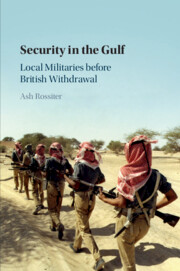Book contents
- Security in the Gulf
- Security in the Gulf
- Copyright page
- Contents
- Preface
- Abbreviations
- Introduction
- 1 Patterns of Protection in the Gulf
- 2 British India and Local Security Arrangements
- 3 Local Militaries and Intensified British Interests
- 4 Intervention or Local Means of Coercion?
- 5 Local Forces and Britain’s Silver Age in the Gulf
- 6 Securing the Gulf after Britain’s Withdrawal
- Conclusion
- References
- Index
6 - Securing the Gulf after Britain’s Withdrawal
Published online by Cambridge University Press: 15 June 2020
- Security in the Gulf
- Security in the Gulf
- Copyright page
- Contents
- Preface
- Abbreviations
- Introduction
- 1 Patterns of Protection in the Gulf
- 2 British India and Local Security Arrangements
- 3 Local Militaries and Intensified British Interests
- 4 Intervention or Local Means of Coercion?
- 5 Local Forces and Britain’s Silver Age in the Gulf
- 6 Securing the Gulf after Britain’s Withdrawal
- Conclusion
- References
- Index
Summary
As the end of 1971 approached, British planners began to think more carefully about Britain’s post-withdrawal role in the Gulf. They calculated that Britain’s ability to remain influential would rest to a large degree on the rulers’ continued dependence on Britons to fill critical advisory and leadership positions related to security matters. After all, the presence of British nationals, whether loaned out by Britain or privately employed, was a critical component in the development of indigenous security forces prior 1971 and one of the central planks of the British relationship with the Gulf ruling families. Because the influence of Britons in key positions in the security apparatus was not dependent on the formal aspects of Britain’s political and military position in the Gulf, it is perhaps not surprising that it continued long after Britain’s formal military withdrawal – right up to the present day.
- Type
- Chapter
- Information
- Security in the GulfLocal Militaries before British Withdrawal, pp. 209 - 270Publisher: Cambridge University PressPrint publication year: 2020

